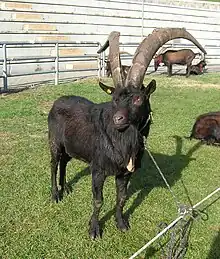 | |
| Conservation status | |
|---|---|
| Other names | Chamoisée Valdôtaine |
| Country of origin | Italy |
| Distribution | Valle d'Aosta |
| Standard | MIPAAF |
| Use | |
| Traits | |
| Weight | |
| Height | |
| Wool colour |
|
| Horn status | large and sabre-shaped in both sexes |
| |
.jpg.webp)
The Valdostana is an Italian breed of domestic goat from the autonomous region of Valle d'Aosta in north-western Italy, from which it takes its name.[3] It is characterised by large sabre-shaped horns, which it uses in combat in the traditional local sport of goat-fighting.
It is an endangered breed: its conservation status is listed in DAD-IS as 'critical'.[1]
History
The Valdostana is a traditional regional breed of the autonomous region of Valle d'Aosta in north-western Italy, from which it takes its name.[3] The earliest written documentation of it dates from 1917.[4]: 415 It is reared particularly in the Val d'Ayas and in the Valle di Gressoney, and also in the Val Chiusella, the Valle di Locana and the Val di Susa in the upper Canavese, in the province of Turin, in Piemonte.[3] It was in the past distributed in the Alpi Graie and Alpi Pennine.[3]
It is one of the forty-three autochthonous Italian goat breeds of limited distribution for which a herd-book is kept by the Associazione Nazionale della Pastorizia, the Italian national association of sheep- and goat-breeders.[5]
It is a rare breed: in 2007 its conservation status was listed by the FAO as 'critical'.[6]: 68 At the end of 2013 the registered population was variously reported as 959[7] and as 856;[8] in the 2020 the total number reported to DAD-IS was 71.[1]
Characteristics
The Valdostana is a rustic solidly-built goat of Alpine type, well suited to the mountainous terrain of the region.[4]: 415 There is considerable variation in the colour of the coat, which may be ashen, black, brown, or dark grey with some blond hair. The horns in both sexes are sabre-shaped and large;[4]: 415 this may be partly the result of selective breeding by farmers to improve the fighting ability of the animals.[9]
Use
The Valdostana is kept both for meat, which is consumed both fresh and preserved in the form of goat salame, of Motsetta or of Violino di Capra; and for milk, which is used for cheese-making.[3] A study in 2002 found the average milk yield to be 249 kg in 197 days.[9]
It is much used in the traditional sport of goat-fighting, the bataille des chèvres. Since 1998 this sport has been regulated by the Association Comité Régional Batailles des Chèvres, which organises an annual regional championship.[3]
References
- 1 2 3 Breed data sheet: Valdostana / Italy (Goat). Domestic Animal Diversity Information System of the Food and Agriculture Organization of the United Nations. Accessed October 2022.
- 1 2 3 4 Le razze ovine e caprine in Italia (in Italian). Associazione Nazionale della Pastorizia: Ufficio centrale libri genealogici e registri anagrafici razze ovine e caprine. p. 111. Accessed June 2014.
- 1 2 3 4 5 6 Daniele Bigi, Alessio Zanon (2008). Atlante delle razze autoctone: Bovini, equini, ovicaprini, suini allevati in Italia (in Italian). Milan: Edagricole. ISBN 9788850652594. p. 400–401.
- 1 2 3 Valerie Porter, Lawrence Alderson, Stephen J.G. Hall, D. Phillip Sponenberg (2016). Mason's World Encyclopedia of Livestock Breeds and Breeding (sixth edition). Wallingford: CABI. ISBN 9781780647944.
- ↑ Strutture Zootecniche (Dec. 2009/712/CE - Allegato 2 - Capitolo 2) (in Italian). Ministero delle Politiche Agricole Alimentari e Forestali. Section I (e). Archived 4 December 2013.
- ↑ Barbara Rischkowsky, D. Pilling (eds.) (2007). List of breeds documented in the Global Databank for Animal Genetic Resources, annex to The State of the World's Animal Genetic Resources for Food and Agriculture. Rome: Food and Agriculture Organization of the United Nations. ISBN 9789251057629. Accessed June 2014.
- ↑ Consistenze Provinciali della Razza Q5 Valdostana Anno 2013 (in Italian). Associazione Nazionale della Pastorizia: Banca dati. Accessed June 2014.
- ↑ Breed data sheet: Valdostana/Italy. Domestic Animal Diversity Information System of the Food and Agriculture Organization of the United Nations. Accessed June 2014.
- 1 2 Norme tecniche della popolazione caprina "Valdostana": standard della razza (in Italian). Associazione Nazionale della Pastorizia. Accessed June 2014.